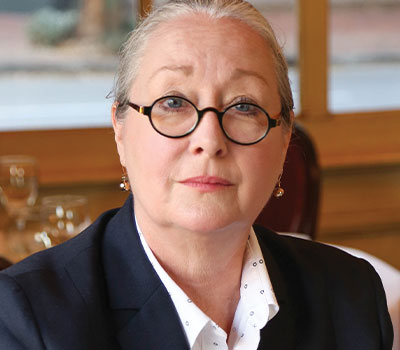August’s approach to elegant and contemporary French cuisine is reflected in the wine program curated by Erin Ryan White. While perennial classics make up the foundation of the list there are also fresh and interesting global selections such as timorasso and English traditional method sparkling. As the demand for Burgundy outgrows supply, White hopes that more guests will become interested in riesling. —Elaine Kim Heide


The August wine program offers about 60 wines by-the-glass with a big section dedicated to fortified and sweet. What is your approach to pairing food and wine?
My wines by-the-glass are all selected and changed according to the menu, which changes constantly. We have a tasting menu with designated pairings but all of the wines by-the-glass are intended for certain dishes. If somebody is starting with the lobster salad, then the staff knows which wines by-the-glass go with the lobster salad. People gravitate to certain styles of wine but if something doesn’t go with our food, I don’t feel we should offer it by-the-glass. I don’t want the guest to stumble into a pairing that will be displeasing. They can do it, if they order from the cellar because we have 325 selections, so they can go wrong that way. But as far as what I’m pouring by-the-glass, we make sure that it clicks with the menu completely.
I don’t know if there’s a philosophy to pairing. I’ve been doing the pairings for August now for 13 years. Last week, we offered an oxtail tortelli as a second course. I wasn’t quite ready to go to a red yet. I started with sparkling, I wanted to go to white, and then move onto red. Everyone thinks that beef or oxtail needs to be paired with red. But I looked at the other ingredients. The protein isn’t that important; it’s all about the sauces and preparation. I ended up going with a Latour white Burgundy for acidity and brightness. Most people react with surprise, but they say, “wow, that really works.”
I’ve been reading this NY Times bestseller called Think Again and I think this year I’ve been trying to be a little more open to not following the past rules of what people think go together. But pairings are always subjective and there are different focal points in a dish. I think with each dish you could find a dozen wines that are perfect pairings for it.
You’ve shared that 15–25% of your list is composed of lesser-known wines. How do you define what is lesser-known in your wine program?
It’s about getting people off cab and chard and getting them onto albariño and fiano, even though those aren’t really that unusual anymore. We poured English sparkling rosé all summer and that was a little surprising for people (Bolney Cuvée Rosé). Granted, it was pinot noir, so not an unusual variety, but it was something people wouldn’t shop for without getting to try first.
Do you find that your guests have curiosity about these wines that they have not heard of or do they lean toward classics?
It’s an individual’s personality. How adventurous are they in life? Some people need the comfort of a variety that feels like they’re putting on slippers. My whole focus with the wine list is like a little kid in school who has that big box of crayons. I want to have something for everyone so I try and make sure that there’s a balance. Right now, I’m pouring timorasso from La Spinetta and also a Vouvray Sec. I have the English sparkling rosé but also classic Champagne—I try to give guests the opportunity to try something unusual. I’m pouring an orange wine from Fonterenza (Toscana Bianco) for someone that wants something natural. I have something that will take care of everybody.
Your staff favorites last year included Massa Timorasso, Donafugata Passito, and Gonnet Châteauneuf de Pape. What made these wines favorites?
With the timorasso it was the fact that people didn’t know it, and it had a good story about almost being extinct and sort of being saved. The fact that it’s this ancient Roman grape and that all these people through history have had this wine with their dinner. It’s more than a beverage at that point, it’s a little piece of history.
Châteauneuf is just one of the European wines that people seem to gravitate to. We were pouring Gonnet, which has power. People who drink Napa, for instance, think that grenache is not a great wine because it doesn’t have all that power. Gonnet is 50% syrah which is like baby stepping away from massive cab to something French that still has some power. It was well received. We had lamb and duck on the menu that a bold blend was nice with.
You shared that Burgundy is the category that guests are increasingly asking for. Is the interest in these wines going up?
We certainly sold more Burgundy last year than we had in previous years, and some of that could be that some of the Napa prices have gotten to the point where they’re so high that you know, it makes Bordeaux and Burgundy look more affordable.
It could be the fact that it’s a little harder to find. People don’t necessarily buy it for home so when they’re out to dinner they’re more interested in Burgundy. This is usually when people want help, too, so they’ll have a conversation about why we’ve selected these wines.
I think that pinot noir and Burgundy are not predictable, which is why I think that people that have been drinking wine a long time end up there. With certain varieties, if you know the age and where it’s from, you have an idea of how it will drink. Burgundy is less predictable and more interesting. Expecting a wine to be the same since the last time you had it won’t happen with Burgundy. I think people are getting a little more comfortable with that idea.
This is a W&S web exclusive. Get access to all of our feature stories by signing up today.

















